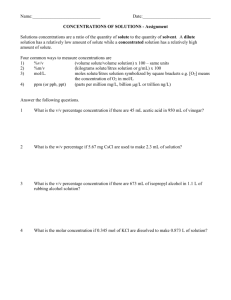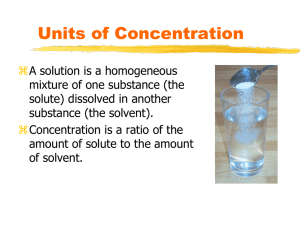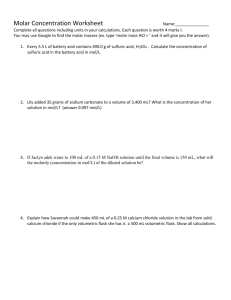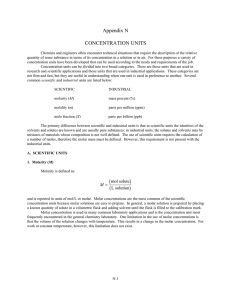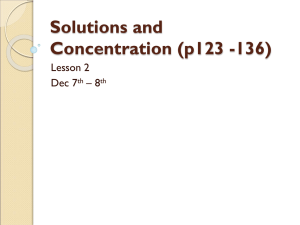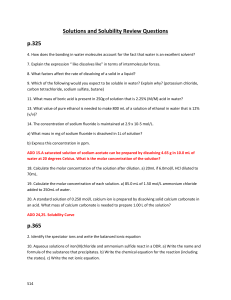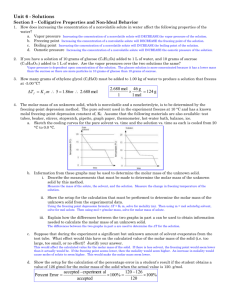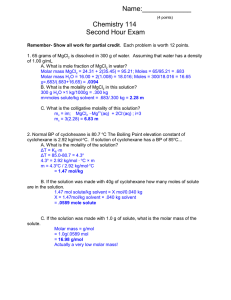Concentration of Solutions
advertisement
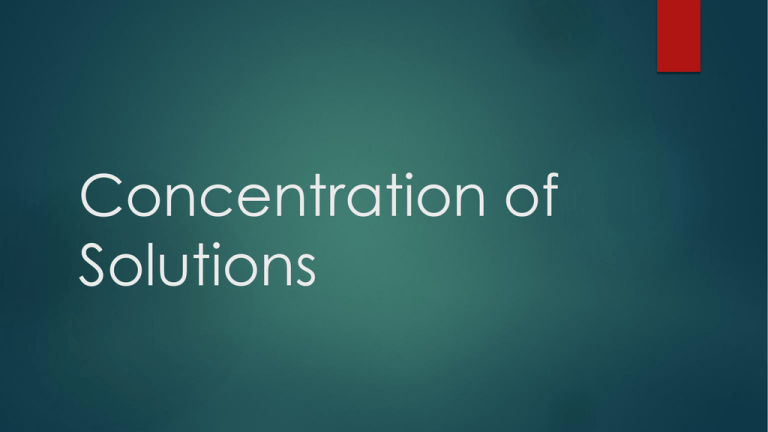
Concentration of Solutions Concentrations of Solutions (Section 2.5) Concentration = quantity of solute quantity of solution A solution is dilute if there is a relatively small amount of solute per unit volume of solution. A solution is concentrated if there is a relatively large amount of solute per unit volume of solution. Percentage Concentration A photographic “stop bath” contains 160 mL of acetic acid in 600 mL of solution. What is the (v/v) percentage concentration of acetic acid in the stop bath? A salt solution is formed by mixing 2.80 g of NaCl in enough water to make exactly 250 mL of solution. What is the (w/v) percentage concentration of salt in this solution? Concentrations of very small amounts ppm (parts per million) ppb (parts per billion) ppt (parts per trillion) ppm = milligrams (mg) volume in Litres The maximum permitted mass of lead in 1.0 L of public drinking water is 5.0 X 10 -5 g. What is this concentration in ppm? Molar Concentration Molar concentration is sometimes indicated by square brackets [ ] i.e [NH3] means the molar concentration of NH3 [1.5] means a concentration of 1.5 mol/L A solution is prepared by dissolving 1.68 g of CuSO4 in enough water to make 150 mL of solution. Calculate the molar concentration of CuSO4. Sodium carbonate (Na2CO3) is a water softenerr that makes up a significant part of laundry detergent. A student dissolves 5.00 g of sodium carbonate in enough water to make 250 mL of solution. What is the molar concentration of Na2CO3 in this case? A sample of NH3solution has a concentration of 14.8 mol/L. How many moles of NH3 would be present in a 1.50 L bottle of this solution? What volume of a 5.0 mol/L glucose solution contains 2.5 mol of glucose? Diluting Aqueous Solutions A stock solution is a solution whose concentration is precisely known. Dilution is the process of decreasing the concentration of a solution by adding more solvent (usually water). When more solvent is added to a solution it does not change the amount of solute present. It only changes the volume of the solution. If you double the volume of a 6% H2O2 solution what will the new concentration be? 3% H2O2 There is a fairly simple equation that relates the initial and final concentration and volumes when a solution is diluted. Ci = the initial concentration of the solution Cf = the final concentration of the solution Vi = the initial volume of the solution Vf = the final volume of the solution CiVi = CfVf Using this equation you can solve for any of the variables. Just be careful that if you have two concentrations that they are measured in the same unit or if you have two volumes that they are both be measured in the same unit. Calculate the new concentration (molarity) if enough water is added to 100mL of 0.25mol/L sodium chloride to make up 1.5L. Calculate the volume to which 500mL of 0.02mol/L coppper sulfate solution must be diluted to make a new concentration of 0.001mol/L. If I have 340 mL of a 0.5 M NaBr solution, what will the concentration be if I add 560 mL more water to it? If I leave 750 mL of 0.50 M sodium chloride solution uncovered on a windowsill and 150 mL of the solvent evaporates, what will the new concentration of the sodium chloride solution be? To what volume would I need to add water to the evaporated solution in problem 3 to get a solution with a concentration of 0.25 M?



